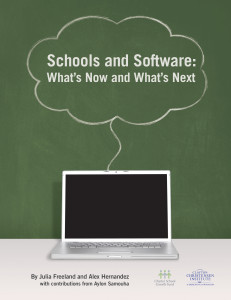Download the full white paper
Download the school systems’ software maps
By Julia Freeland and Alex Hernandez
With contributions from Aylon Samouha
June 2014
EXECUTIVE SUMMARY
Do we know what software tools school systems actually want? Demand-side analyses typically reflect the loudest voices in the market that companies are eager to please—in the case of education technology, the largest urban districts with the largest technology budgets. But half of the nation’s 48 million public school students attend approximately 3,700 small- to medium-sized school systems. These school systems face some of the same struggles as large districts in delivering high-quality blended learning and running effective and efficient central offices. They also face distinct challenges in the marketplace, as they find themselves unable to afford large enterprise solutions or powerless to push suppliers to customize to their particular needs.
To answer the question of what these school systems want, we surveyed education leaders in 30 small- to medium-sized public school systems that each serve between approximately 2,500 to 25,000 students to shed light on developing education technology trends and desires. Many of these 30 school systems are operating at the leading edge of technology integration among small- to medium-sized systems. As such, this sample does not reflect the status quo across all systems of a similar size, but rather points to where we think such systems are headed as technology inevitably improves and becomes more affordable and accessible.
K–12 software has long been a source of aggravation and disappointment. But many of the school systems we surveyed believe software can be used strategically to improve student achievement and overall organizational performance. More and more, school systems are hiring technology for sophisticated jobs like blending learning environments, supporting data-driven practices, and recruiting and supporting teachers.
In the interviews with leaders in each of these 30 school systems, we heard about the following trends in technology usage and demand among small- to medium-sized school systems:
Academic software
- Schools and students suffer when software vendors don’t cooperate. School systems want to use a suite of online-learning programs, but vendors are focused on developing their own proprietary products. This leaves school systems with the challenge of creating compelling and integrated student experiences from a patchwork of programs that don’t talk to one another.
- Can learning software delight both students and teachers? Schools are clamoring for online-learning programs that let teachers choose what students work on and automatically adjusts to student needs, even though most online-learning programs skew heavily toward one end of this spectrum or the other. Significant ambivalence remains over how much control teachers and students actually want or need.
- Building trust with educators is essential. The inability to extract meaningful data from online-learning programs can negatively impact perceptions of product quality and limit educators’ trust in these programs. Moreover, information about the effectiveness of online-learning programs should be communicated in terms of how it is actually used in real classrooms. Efficacy studies should shift their focus from “what works” to “what works, for which students, in what circumstances.”
- The next generation of effective and intuitive online learning. Future opportunities exist for education technology companies to create products with a better mix of student and teacher control, natively Common Core-aligned content, and more intuitive design that requires less product training.
Business and operations software
- Schools get more attention than the back office. School systems generally appear more focused on academic- and school-related software than business and operations solutions. The school systems surveyed also were more likely to use software mandated by other agencies for back-office functions.
- The (small) customer may be right … but will not drive supply. Early-stage and thinly resourced software companies cannot afford to heavily customize their products for smaller customers, and small- to medium-sized school systems have limited resources to pay for such changes. Therefore, these school systems often face a tradeoff between comprehensive, legacy enterprise solutions that can be difficult to use, disparate point solutions that do not talk to one another, or large enterprise applications that are designed and priced for much larger entities.
- Better solutions created by schools, for schools? A few charter management organizations (CMOs) are leading the charge to develop more integrated solutions for human resources, finance, and operations through in-house development or in partnership with existing vendors. Successful software vendors outside of the K–12 market, such as Workday or Zenefits, might also contemplate serving schools down the line. Public school systems’ human resources and finance systems are so complex, however, that such vendors may shy away from the K–12 space.
Software and data integrations
- Message to K–12 software vendors: There is no “I” in “team. Many K–12 software programs offer limited value on a stand-alone basis and must be integrated with other software, typically from different vendors, to realize their full potential. Software integration challenges are primarily “cooperation” issues, not technical issues per se. Thus, school systems and investors should demand cooperation at the outset.
- A few software products to rule them all. Student information systems (SIS), human resources information systems (HRIS), and domain management or identity management systems (e.g., Active Directory, Google Apps Administrator) are “sources of truth” because of the critical data they collect. They sit at the center of most software integrations. These “hub” platforms create a highly centralized architecture around which nearly all other programs must be integrated—automatically or manually. Such dominant platforms wield strong influence and school systems can become locked into these vendors as a result.
- Room for one more? New hubs may emerge that upset the current balance of power in software architectures. For example, the school systems surveyed are adopting Google Apps for Education either alongside or in place of Active Directory and Microsoft Exchange, which have historically been the default solution. New “hub” categories may be created altogether as well. For example, several school systems are exploring talent management solutions (e.g., software that facilitates teacher evaluation, coaching, and professional development) that, in the future, could potentially sit alongside the SIS, HRIS, and identity management products as a fourth major platform.
- Manual integration costs schools. Manual integration across various software platforms and programs causes major headaches and inefficiencies for school systems. Automated provisioning of software licenses and single sign-on technologies are slowly addressing some of these pain points. Neither of these, however, helps to integrate data coming out of disparate software systems. As a result, some school systems are implementing data marts or data warehouses, and a number of CMOs are actually attempting to build data solutions in-house.
- School systems will pay for help with their data. Education technology companies that help school systems analyze and manage data—like BrightBytes, Clever, Education Elements, LearnSprout, MasteryConnect, and Schoolzilla—are drawing significant interest from both customers and investors, which potentially signals healthy growth ahead for this segment of the education technology market.
IT management and hardware
- IT departments are becoming more strategic and valued by their school systems. In school systems pursuing blended learning, chief information officers and other key IT leaders increasingly possess hybrid backgrounds that combine deep technology and instructional expertise. IT departments are becoming less siloed within school system organizations and are playing a more active and strategic role across the enterprise, especially with respect to teaching and learning.
- Next stop, the cloud. Small- to medium-sized school systems have shifted or are in the process of shifting to cloud-based software to support instruction and operations. This stands to make IT management and workflow more efficient, but presents new hurdles in terms of data privacy and challenges the existing paradigm of central control over IT systems.
- Wanted: Minimum, viable devices. School systems pursuing blended learning are looking for affordable, manageable, and reliable devices to support their instructional models and online assessments. Chromebooks appear to be gaining traction along these dimensions, but remain limited by the inability to support software that must be downloaded, such as early versions of assessment systems like Northwest Evaluation Association’s (NWEA) Measures of Academic Progress (MAP).
- BYOD is the future. As more students and staff own consumer mobile and computing devices, school systems will be more likely to move toward device agnostic and bring your own device (BYOD) environments. This in turn will require that schools implement new networking, device management, and security solutions.
By highlighting the particular trends and burgeoning demand across these school systems, we hope that investors and vendors will find new opportunities to target neglected pockets of the market, and small- to medium-sized school systems will work together to spur products that are better suited to systems of their size.
Download the full white paper
Download the school systems’ software maps



